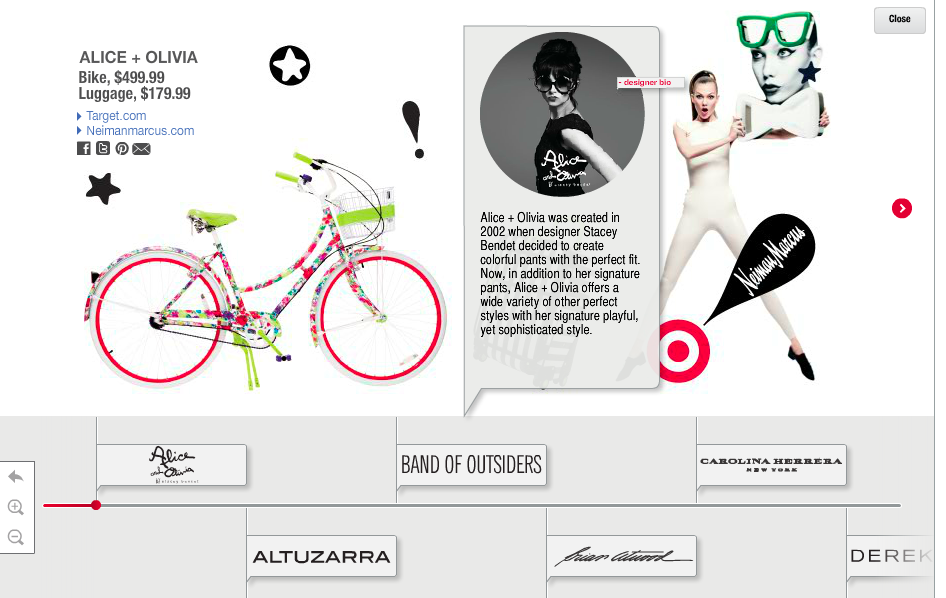
Like many publications, The New York Times has a banner ad problem. The problem is this: the Web is littered with banners and new computer-driven methods of buying discrete audiences is putting even further pressure on the display ad market.
But unlike newfangled publications like BuzzFeed, the NYT isn’t giving up on the banner. In fact, it wants to reinvent it by giving it a heavy dose of the same tech savvy behind its recent pathbreaking interactive feature, “Snow Fall.”
Inside the NYT’s Idea Lab, a team of 10 works to save the banner ad. The lab itself is an offshoot of NYT’s R&D Lab, which was set up to come up with new technologies for storytelling. Think of the three-year-old Idea Lab as something similar, only it works with agencies and brands to help advertisers tell stories in modern, interesting ways.
So far, the Idea Lab has created 21 different ad products for clients like Chevron, Target and G.E., among others. One example is where the Idea Lab took a Google Hangout idea to its Energy for Tomorrow Conference last April. G.E was the lead sponsor, and the team created the ability for its readers to watch the conference broadcast from the Times Center in real time through a G.E. ad unit on the NYT homepage, as well as ask questions that were fed to moderators on stage. It’s the kind of interactivity and creativity you simply don’t see out of the mass-produced, speedily traded world of standard display ads.
“The idea of being able to watch through an ad unit was really important, and we worked with them pretty hard to make sure it would be seamless,” said Andy Goldberg, creative director of global advertising at G.E. “We weren’t going for the mass consumer. This was a finite target and, for us, was successful.”
Another interesting custom ad unit is a timeline, which tracks the progress of events related to a brand. Target used this ad for its holiday campaign highlighting 24 high-end designers. The execution turned out to be a homepage takeover ad where a different designer, plus a blurb and description of their product, comes through as you scroll across the unit. There’s a click-through to shop the collection, as well as social buttons. This unit stemmed from work the publication did during the last World Cup where you could see, on a day-to-day basis, which players were the most active on Facebook.

“This is a way for us to engage with a client where we might use standard banners, but it lets us engage with clients before they go out into programmatic channels, which is something that’s strategically important for us,” said Todd Haskell, group vp of advertising. “So when we do these kinds of things, this kind of stuff cannot be replaced by an audience extension play versus via some trading desk.”
And this is important as the NYT continues to figure out its future. The company reported a loss of print and digital ad revenue in the third quarter, down 8.9 percent to $182.6 million, from $200.5 million. The silver lining: Digital ad revenue has been creeping up and now makes up about a quarter of the company’s ad revenue. Haskell wouldn’t divulge pricing on the new units.
“They realized they have a bright shiny jewel there, and becoming a lot more comfortable having advertisers participate in those kinds of programs,” said Barry Lowenthal, president of The Media Kitchen. “They’re letting the advertisers try on the jewels. I’d love to see more publications do those kinds of things.”
The Idea Lab has more executions in the works. One called Spark builds off the application-programming interface of Cascade, a visualization of how NYT stories travel throughout Twitter and how the stories and the conversations that follow gain traction from influencers. Cascade was used internally for journalists to see how stories moved across the social network. The idea is to use the functionality for brands. Spark tracks the top 15 trending articles on Twitter when they’re trending, and an advertiser can be aligned with this by having a pencil ad alongside the trending list.
Another, called “Product Zoom,” was inspired by this interactive article from October 2011 about the opening of the Islamic Wing at the Met. Readers could zoom in and taking a look at the detail of the craftsmanship. The Idea Lab built the same zoom approach into a unit so that a brand can showcase a product’s finer details as a user moves the cursor over an image. A luxury good, like a watch, would be a hypothetical example of an instance where a reader can go inside and check out what makes it tick.
The efforts are a way for the NYT to stand out at a time when publishers are blurring the lines between editorial and advertising under the “native advertising” catchall. That’s not going to fly at The Gray Lady.
“Sure, there are things that an outlet like BuzzFeed does that go further than we’d be willing to go in terms of brand integration inside of content in ways that are confusing to the reader,” Haskell said. “This is a brand-appropriate approach to that same sensibility, which is to create something that will work well with your readers because of the nature of the messaging within our content to our brand.”
The Times has no plans to stop running standard units anytime soon, but it has hopes the Idea Lab will hit on premium complements to the tried-and-true — complements that can’t be commoditized on ad exchanges. In one nod to scale, however, the NYT allows advertisers to use the ads on other sites. A NYT spokesperson said that so far, only one client ran a unit offsite.
“The challenge of any advertising format is to achieve scale: You want to, as an agency, place one buy and get your fantastic ad campaign in 20 to 30 million homes at a pop,” said Interactive Advertising CEO Randall Rothenberg. “The easiest way to achieve scale is to participate in the bottoms-up industry-wide programs to develop and implement these standards.”
More in Media

Earnings from social and search players signal that AI will be a long-play investment
Giants like Google, Meta and Microsoft say investors and advertisers might have to wait longer for AI to generate a better return on investment.

Why some publishers aren’t ready to monetize generative AI chatbots with ads yet
Monetization of generative AI chatbot experiences is slow going. Some publishing execs said they’re not ready to add advertising to these products until they scale or can build a subscription model first.

Media Briefing: Publishers who bet on events and franchises this year are reaping the rewards
Tentpole events and franchises are helping publishers lock in advertising revenue.





